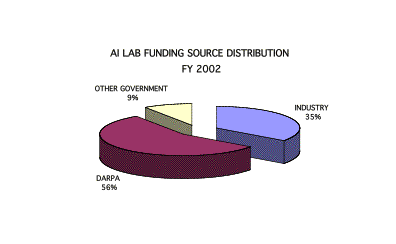Artificial Intelligence Laboratory
The MIT Artificial Intelligence Laboratory (AI Lab) added new faculty during the year and embarked in new areas of research. Professor Bill Freeman joined the Department of Electrical Engineering and Computer Science and became a member of the AI Lab and part of the vision group within the AI Lab. He is working on fundamental questions of computer vision and graphics. Professor John Leonard of the Department of Ocean Engineering became an affiliate of the laboratory and while not housed in the lab's space, has started collaborations with other laboratory faculty members in the realm of mobile robot navigation and localization.
During the year we also lost a valued faculty member, Professor Gill Pratt who moved to Olin College of Engineering. Professor Hugh Herr, who holds positions at Harvard and at MIT through the Whitaker College, has taken over the Leg Lab within the AI Lab.
Professor Tommi Jaakkola initiated new research in machine learning applying techniques to problems in understanding gene regulatory mechanisms. The early results are very promising. Professor Patrick Winston started a new initiative in modeling political processes. Dr. Tom Knight started a new wet biology project in re-engineering the genome of one of the smallest living creatures, a mycoplasma. Professor Rod Brooks started a new research group trying to understand the fundamental organizing principles of living systems with the goal of building a living machine.
Besides these new efforts there were many continuing projects with significant research results. Professor Eric Grimson's visually guided surgery group developed new tools for virtual colonoscopies. Professor Tommy Poggio and his student Tony Ezzat developed a new photo-realistic method for generating movies of real individuals saying or singing things that they had not really said or sung. Dr. Boris Katz and his student Jimmy Lin developed new mechanisms for automatically annotating web pages so that retrieval programs can understand the content of the web pages they search, rather than simply use keyword matching. Professor Randy Davis and his students rebuilt their sketch understanding systems so that they can be applied to new domains, providing a natural interface to existing large software systems. Dr. Howie Shrobe and his students developed systems that can understand meetings between people providing an automatic annotation of what transpires. Professor Trevor Darrell and his students developed new vision techniques to determine head pose, body disposition, lip motion, and sound localization. Professor Brian Williams built new planning and monitoring systems for onboard deep space missions. Professor Berthold Horn worked on new methods for reconstructing medical images from dispersed light sources. Professor Ted Adelson developed new techniques for extracting the properties of materials in images. Professor Leslie Kaelbling developed new learning techniques for mobile robots. Professor Gerry Sussman and his students continued to develop local techniques for large collections of physically distributed computational elements to self-organize spatially.
The disastrous events of September 11th had an impact on the research of many faculty members within the laboratory. We have initiated a number of new projects and project proposals that emphasize extracting patterns from vast amounts of disparate data, in interpreting image sequences of human activity, and in understanding natural language documents better. The full ramifications of this re-emphasizing of research directions have yet to be fully played out. Clearly there is a transition as the federal government redirects its funding levels to these new problem areas. One concrete result has been the initiation of an effort with the Laboratory for Computer Science to explore the possibilities of deeper collaboration with MIT Lincoln Laboratories in areas of national defense.
The Artificial Intelligence Laboratory is involved in two large industrial research efforts, both in conjunction with the Laboratory for Computer Science. During this year we completed the fourth year of a five-year research agreement with NTT. We also completed the second year of the Oxygen Project in alliance with NTT, Philips, Nokia, Acer, Delta Electronics, and Hewlett Packard.
The research funding level for the laboratory was $12.15 million. DARPA provided 56 percent of this funding, while other government sources accounted for nine percent. Corporate funding, mainly from NTT and Project Oxygen, accounted for the remaining 35 percent. As the effects of the technology sector downturn continue we expect that it will be very hard to maintain that level of corporate funding beyond this coming year—even if technology sectors experience a significant upturn we will be effected by a lagging trough in funding.
 |
The total head count for the Artificial Intelligence Laboratory was 310 people. This includes 20 full time faculty, 130 graduate students supported by research assistantships, and 40 supported by teaching assistantships, fellowships, and self-supporting. We had 35 UROPs working at the AI Lab throughout the year. We had 17 research scientists and three research engineers, along with 20 post-doctoral students. We had 12 visiting scientists and 13 research affiliates. Administrative and support staff included five people on the headquarters staff, seven providing direct assistance to faculty members and eight systems administration staff.
For more information on the Artificial Intelligence Laboratory see the web site at http://www.ai.mit.edu/.